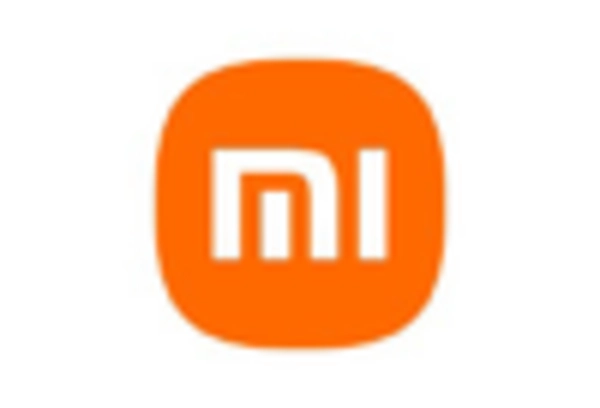Integration of Cloud Services
The smartphone operating-system market is witnessing a trend of integration of cloud services. As users increasingly rely on cloud storage and computing, operating systems are adapting to provide seamless access to these services. In 2025, it is anticipated that cloud-based applications will constitute over 50% of all mobile applications. This shift encourages operating system developers to enhance compatibility with various cloud platforms, ensuring that users can easily store, access, and share data across devices. The integration of cloud services not only improves user convenience but also fosters collaboration and productivity, making it a crucial driver in the smartphone operating-system market.
Increased Focus on Sustainability
The smartphone operating-system market is influenced by a focus on sustainability. As environmental concerns gain prominence, consumers are becoming more conscious of the ecological impact of their devices. This shift is prompting operating system developers to incorporate energy-efficient features and promote sustainable practices. By 2025, it is estimated that over 30% of consumers will prioritize eco-friendly devices in their purchasing decisions. Operating systems that facilitate energy conservation, extend battery life, and support recycling initiatives are likely to gain traction. This emphasis on sustainability not only aligns with consumer values but also encourages innovation within the smartphone operating-system market, as companies strive to meet the growing demand for environmentally responsible solutions.
Emergence of 5G-Enabled Applications
The smartphone operating-system market is being propelled by the emergence of 5G-enabled applications. As 5G technology becomes more prevalent, developers are creating applications that require high-speed connectivity and low latency. This trend is expected to drive demand for operating systems that can support these advanced applications, which may include augmented reality, virtual reality, and real-time gaming. By 2025, it is projected that 5G-enabled applications will represent a substantial portion of the app market, influencing operating system design and functionality. Consequently, operating system providers are likely to prioritize features that enhance performance and compatibility with these innovative applications, thereby shaping the future of the smartphone operating-system market.
Growing Demand for Enhanced User Experience
The smartphone operating-system market is experiencing a notable shift towards enhancing user experience. As consumers increasingly seek intuitive interfaces and seamless interactions, operating systems are evolving to meet these expectations. In 2025, user experience is projected to influence over 60% of purchasing decisions in the smartphone sector. This trend compels developers to prioritize features such as customization, accessibility, and responsiveness. Companies are investing heavily in research and development to create operating systems that not only function efficiently but also provide a visually appealing and user-friendly environment. This focus on user experience is likely to drive competition among operating system providers, ultimately benefiting consumers with more innovative and tailored solutions.
Advancements in Mobile Connectivity Technologies
The smartphone operating-system market is significantly impacted by advancements in mobile connectivity technologies. The rollout of 5G networks across the United States is expected to enhance the performance of smartphones, leading to increased demand for operating systems that can leverage these capabilities. By 2025, it is estimated that 5G will account for approximately 40% of mobile subscriptions in the US. This shift necessitates operating systems that can efficiently manage higher data speeds and lower latency, enabling applications that require real-time processing. Consequently, operating system developers are likely to focus on optimizing their platforms to fully utilize the potential of 5G, thereby driving growth in the smartphone operating-system market.

















Leave a Comment